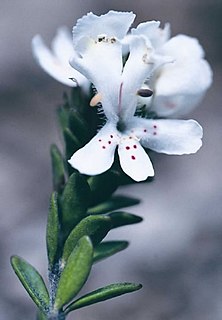
Westringia is a genus of Australian shrubs. As with other members of the mint family their upper petal is divided into two lobes. There are four stamens - the upper two are fertile while the lower two are reduced to staminodes. The leaves are in whorls of 3 or 4.
Southport Island, with the adjacent Southport Reef, is a 7 ha island in south-eastern Australia. It is part of the Actaeon Island Group, lying close to the south-eastern coast of Tasmania, at the southern entrance to the D'Entrecasteaux Channel between Bruny Island and the mainland.
Westringia cremnophila, commonly known as Snowy River westringia, is a flowering plant in the family Lamiaceae, a rare shrub that is endemic to Victoria, Australia. It is a small shrub with leaves mostly in groups of three and white flowers.

Westringia eremicola, commonly known as slender westringia or slender western rosemary, is a flowering plant in the family Lamiaceae and is endemic to eastern Australia. It is a small shrub, with narrow leaves and pink, mauve to white flowers.

Westringia rigida is a shrub in the Lamiaceae family that is endemic to Australia. and

Westringia kydrensis, also known as the Kydra Westringia, is a species of plant in the mint family that is endemic to Australia.

Westringia saxatilis is a species of plant in the mint family that is endemic to Australia.

Westringia davidii, also known as David's Westringia, is a species of plant in the mint family that is endemic to Australia.

Westringia tenuicaulis, also known as the Tufted Westringia, is a species of plant in the mint family that is endemic to Australia. Its natural range is restricted to the Fraser Coast Region of south-eastern Queensland, between Bundaberg and Sippy Downs.

Westringia sericea, also known as native rosemary or silky rosemary, is a species of plant in the mint family that is endemic to Australia.

Westringia lucida, also known as Shining Westringia, is a species of plant in the mint family that is endemic to Australia.
Westringia longepedunculata is a species of plant in the mint family that is endemic to Australia. It is found in south-eastern Queensland, and is sometimes considered to be a synonym of Westringia cheelii.

Westringia angustifolia, commonly known as scabrous westringia, is a flowering plant in the family Lamiaceae and is endemic to Tasmania. It is a small, upright shrub with mauve or white flowers.

Westringia ophioglossa is a species of plant in the mint family that is endemic to Western Australia.

Westringia fitzgeraldensis is a species of plant in the mint family that is endemic to Western Australia.
Westringia lurida is a species of plant in the mint family that is endemic to Australia. It occurs in the Mallee region of north-western Victoria.

Westringia grandifolia is a species of plant in the mint family that is endemic to Australia. It occurs in wallum habitats in south-eastern Queensland, and is listed as Endangered under Queensland's Nature Conservation Act 1992.

Westringia brevifolia, also known as the greater shortleaf westringia, is a species of plant in the mint family that is endemic to Tasmania.

Westringia cheelii is a species of plant in the mint family that is endemic to Australia.

Westringia capitonia is a species of plant in the mint family that is endemic to Western Australia.

















